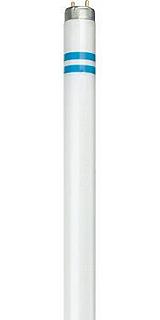Philips Lighting provides a very broad range of lighting products, and one of these is the fragment retention fluorescent lamp MASTER TL-D Secura, which can be used with foodstuffs and other sensitive products that must not be contaminated with shards of glass and phosphors in the event of a broken lamp:

The MASTER TL-D Secura fluorescent lamp protects products from discolouring and loss of taste by 90% lower UV emission, and is compliant with HACCP regulations, and also supports HACCP certification.
Easy identification is provided in audit situations by a blue ring at one end of the lamp.
MASTER TL-D Xtra Secura:
This version has a protective Teflon coating that keeps glass and lamp components together in case of accidental breakage - this allows its use in open luminaires in the food and beverages industry.
Broadly, it has the same features and provides the same lighting qualities as the MASTER TL-D Secura, and its extra-long lifetime and reduced early failures mean lower maintenance workload and costs. It also facilitates change from spot to group replacement. Waste and disposal costs are reduced at the end of the product's life.
This lamp is compliant with HACCP regulations and supports HACCP certification, and once again, identification is aided by the blue ring at one end.
Use of LED lighting:
Another way of avoiding the danger of broken glass etc going into foodstuffs is to avoid using fluorescent tubes and instead employ the latest LED light fittings. Although still relatively expensive, LEDs for freezer lighting, for example, provide excellent life with good light, and a low energy consumption. Importantly, LEDs are effectively almost unbreakable, so the problem of potentially shattering of fluorescent tubes (and other types of conventional lamps) is resolved. Many supermarkets and other retail outlets now use LED lighting for freezers.
